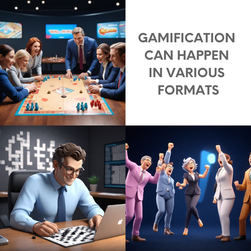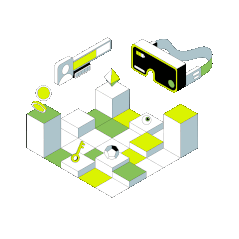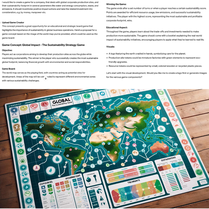When we plan business and strategy communication, we don't usually think of "play" and "game" as this sounds not sufficiently serious. But the
truth is, that the game theory is deeply connected to decision-making psychology, economic behavior, and even to geopolitical events. I find this well explained in this video by science communication expert Derek Muller (about
25min, worth to watch until the end).
As to business, "game" is not at all the opposite of work, gamification tactics can unlock new ways to boost productivity, and loyalty, and
support transformation.
Benefits of Gamification in Business
When you as a corporate communications or HR professional, seek innovative ways to convey messages, engage employees, and foster a culture of collaboration, you should have a closer look at the idea. Gamification (= the application of game-like elements to non-game contexts), in fact, has proven to be a powerful tool and comes with some benefits:
- Employee Engagement: Gamification captivates employees, by raising awareness and increasing engagement with factual information.
- Communication Effectiveness: Game-like elements enhance message recall and comprehension, and can be tailored to various stakeholder groups.
- Collaboration and Teamwork: Well-designed games encourage employees to work together towards shared goals.
- Leadership Development: Gamification can be used to develop leadership skills, such as strategic thinking, and decision-making.
- Data-Driven Insights: Depending on the format, gamified processes, and activities provide valuable data on engagement and interaction with the content.
I purposely left out "Low-Cost Measure" from the list, because, as mentioned in my quiz, there is a range of aspects to consider when creating and deploying a corporate gamification project.
The more specific the activities are, the more effective they are, but they also require more internal and external resources. This includes the content
concept, storylining, production, and rolling out an orchestrated cross-channel campaign that reaches employees from leadership to the shop floor, or further stakeholders.
Gamification can come in digital or physical formats, as individual or team activities, as live experiences or time-asynchronous ones.
Let's take a look at various types of games and think about use cases.
I just want to let you know that I won't be covering any pure team-building activities. While they might foster desired behavior and touch upon issues like leadership and corporate culture, my take is on truly content-related gamification as a tool of corporate messaging, campaigning, and organizational development.
(Providers of activities like chain reactions, escape rooms, and outdoor rallies, will most probably not agree with my distinction, and I am always happy to have a conversation about the topic)
Formats & Opportunities
When talking about gamification in business, most people think about competition, like points and badges, earned for completing tasks, participating in discussions, or achieving milestones. Badges can be awarded for specific accomplishments or levels of expertise. Leaderboards display the top performers in a game or challenge, motivating employees or teams to improve their performance.
This kind of incentivization is pretty common in sales and sometimes also in learning, although the latter
rather builds on challenges or quests that require employees to complete specific tasks or solve problems.
SAP uses gamification in their community , e.g. to help customers implement SAP software. The 'SAP Activate' program provides points, badges, and leaderboards to motivate customers and track their progress. And it works well, helping customers reduce implementation time by 30%.
A similar use case is Deloitte's "Game of Thrones"-inspired "Throne of Knowledge" program used gamification to train employees on new tax laws. The program featured challenges, quests, and leaderboards, and resulted in a 25% increase in knowledge retention.
There are several articles on the benefits of gamification for learning and some providers have specialized to serve the HR and learning market, e.g Testportal, with the option of direct embed in Microsoft Teams.
Information anchoring with crosswords & quizzes
Competition, or at least rewards and acknowledgment mechanisms, are for sure a key feature of gamification and I assume you were disappointed that my intro quiz did not offer any rewards (and hence admittedly did not qualify as 'gamified'). Mentimeter does not allow quiz and leaderboard features with decentralized and audience-paced presentations, that's why I recommend menti as a preferred option for quizzes during in-person and hybrid conferences, but Kahoot! and also Typeform provide advanced settings for access to quizzes across channels and targeted audiences (for both I am not on a paid subscription right now, so menti was the easier option for this blog post 😉)
Beyond simple quizzes, you may also consider crosswords and other letter games as a communication tool, for example, to anchor terms around the corporate values, or sustainability initiatives. While Wordmint is a conventional provider for creating such games, tools like Aspose (free) and others allow superfast creation with AI support.
Playful approach to Operations, Strategy, and Innovation

Gamification is also a valuable tool for driving strategic initiatives and encouraging innovation in the workplace. Game-like challenges can stimulate creativity, foster problem-solving skills, and generate new ideas, but of course application in these areas needs more complex mechanics, and thorough preparation and good guidance. When it comes to creating games for high-level topics or leadership communities, it's all about intrinsic motivation and collaboration, rather than competition.
These kind of games are more time-consuming, the web-based Blue Ocean strategy game, for example, requires 6-12 hours, the Beer Game and the Lean Game by Zensimu both can be played in condensed versions, e.g. during a team offsite, but I recommend some extra time for debriefing and transfer into the specific corporate context.
The Breakthrough Game was designed by Justin Gary, a dedicated business game desiner, who also develops custom games, runs a vivid substack community, and offers mind-opening masterclasses.
Gamification can also help create a culture of innovation within organizations. The book Innovation Games (2006) was written by Silicon Valley agile software
development expert Luke Hohmann. 'Playing' in this concept is gamified detection of customer needs in order 'to create breakthrough products through collaborative
play'. He lays out 12 games including step-by-step implementation guidelines and real-world examples. Reading it, years ago, I was especially impressed by the
thorough organization tips Luke provides to make 'customer play events' a success, from proper expectation management upon invitation all the way to room design and appropriate music to
be played.
Michelle Lee, IDEO Play Lab Executive Design Director, explores the field around play and innovation in the IDEO-U Podcast: "It's also about approaching challenges with curiosity and a willingness to suspend everyday reality for just a bit to be able to dream big and imagine new solutions."
gamify sustainability efforts
I'm currently looking a lot into how we can use gamification to encourage employees to get involved in sustainability initiatives.
Also here, the 'traditional' gamification approach might help, by rewarding employees for adopting eco-friendly practices, reducing waste, and conserving resources, you can encourage sustainable behaviors and promote environmental responsibility.
A nice example of activation is the 10 random acts of green app for companies and other communities (not sure if it is still active, though, the founder is now working with HelloFresh)
But I am convinced that there is much more to playfully explore in this area
- What about developing a quiz to anchor important ESG terms? With Kahoot! and other platforms it is pretty easy to create and host those.
-
As a mind-opener also provocative methods may work, e.g. referring to the common theme of Monopoly to understand
the concept of planet boundaries
- Even good old analogue board games like Carbon City Zero could serve as an unusual intro or evening activity for leadership offsites, but they require a qualified debrief to transfer learnings to business.
- Video games with sustainability topics rarely exist - I only found Terra Nil to play on Netflix and Water 2050 by Totem Games Studios, but McCain's 'Farms of The Future' on Roblox is a valid example of branded entertainment B2C. With AI acceleration of video and game development, we should soon see more cool ESG content games on the market.
You have no idea how to start?
AI can help here, too. I prompted the custom ChatGPT Game Creator (Pro subscription required) to develop a corporate sustainability game, and
it did not only come up with the basic concept including material and visuals, but also proposed channels and creation platforms for
the digital version (PC/Steam via Unity).
In case you want a sparringpartner for the whole process, just reach out! I am into playing and more than happy to co-create your content-driven playful experiences and campaigns.





Write a comment